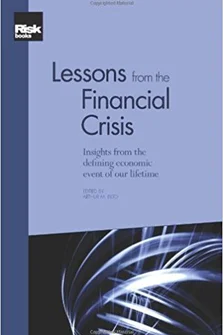Modelling Systemic and Sovereign Risks
Dale F Gray and Andreas A Jobst
Introduction to 'Lessons from the Financial Crisis'
The Credit Crunch of 2007: What Went Wrong? Why? What Lessons Can be Learned?
Underwriting versus Economy: A New Approach to Decomposing Mortgage Losses
The Shadow Banking System and Hyman Minsky’s Economic Journey
The Collapse of the Icelandic Banking System
The Quant Crunch Experience and the Future of Quantitative Investing
No Margin for Error: The Impact of the Credit Crisis on Derivatives Markets
The Re-Emergence of Distressed Exchanges in Corporate Restructurings
Modelling Systemic and Sovereign Risks
Measuring and Managing Risk in Innovative Financial Instruments
Forecasting Extreme Risk of Equity Portfolios with Fundamental Factors
Limits of Implied Credit Correlation Metrics Before and During the Crisis
Another view on the pricing of MBSs, CMOs and CDOs of ABS
Pricing of Credit Derivatives with and without Counterparty and Collateral Adjustments
A Practical Guide to Monte Carlo CVA
The Endogenous Dynamics of Markets: Price Impact, Feedback Loops and Instabilities
Market Panics: Correlation Dynamics, Dispersion and Tails
Financial Complexity and Systemic Stability in Trading Markets
The Martingale Theory of Bubbles: Implications for the Valuation of Derivatives and Detecting Bubbles
Managing through a Crisis: Practical Insights and Lessons Learned for Quantitatively Managed Equity Portfolios
Active Risk Management: A Credit Investor’s Perspective
Investment Strategy Returns: Volatility, Asymmetry, Fat Tails and the Nature of Alpha
The complex interactions, spillovers and feedbacks of the global crisis that began in 2007 remind us how important it is to improve our analysis and modelling of financial crises and sovereign risk. This chapter provides a broad framework to examine how vulnerabilities can build up and suddenly erupt in a financial crisis with potentially disastrous feedback effects for sovereign debt and economic growth. Traditional macroeconomic analysis overlooks the importance of risk, which makes it ill suited to examine interconnectedness and transmission mechanisms in response to common shocks. Against this background, the chapter discusses lessons from the crisis and new directions for research on modelling financial crises and sovereign risk. It shows how risk management tools and contingent claims analysis (CCA) can be applied in new ways to measure and analyse financial system and sovereign risk. A new framework (“Systemic CCA”) is presented, which can help the measurement, analysis and management of financial sector systemic risk, tail risk and associated government implicit and explicit guarantees (contingent liabilities).
Since October 2008, unprecedented and sweeping government
Copyright Infopro Digital Limited. All rights reserved.
As outlined in our terms and conditions, https://www.infopro-digital.com/terms-and-conditions/subscriptions/ (point 2.4), printing is limited to a single copy.
If you would like to purchase additional rights please email info@risk.net
Copyright Infopro Digital Limited. All rights reserved.
You may share this content using our article tools. As outlined in our terms and conditions, https://www.infopro-digital.com/terms-and-conditions/subscriptions/ (clause 2.4), an Authorised User may only make one copy of the materials for their own personal use. You must also comply with the restrictions in clause 2.5.
If you would like to purchase additional rights please email info@risk.net











